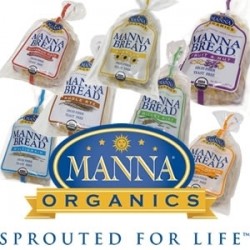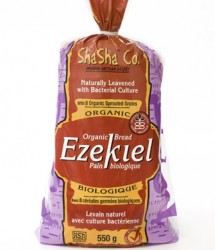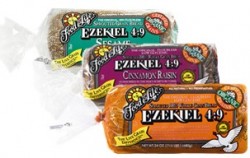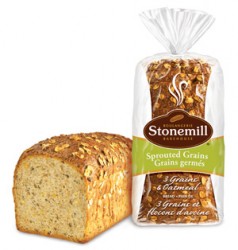Bread has been the staple of the human diet for thousands of years now and a food that is considered a basic staple in most cultures to this day. Yet the bread that our ancestors ate and that we eat today differs so much, that if a visitor were to come from the past, they would hardly recognize some of the food we call bread. Over the past 100 years especially, the quality of bread has degraded a lot, becoming a heavily processed food item. In fact many optimal health experts do not consider ANY bread a healthy choice.
And yet our culture appears to promote bread and bread products around every corner. It is the first thing people see and eat in most restaurants. It is served with soups and salads. Sandwich, sub, pita, wrap, pizza and deli shops are thriving as they provide unsurpassable convenience for the too-rushed-to-eat. And let’s not forget all the doughnut and pastry shops. Most people start their day with bagels or toast, have a sandwich for lunch and finish off with a pasta or pizza dinner. Almost all of these without question are bread products based on refined flours, unhealthy fats, sugars and various chemical additives. Is it any wonder we have the weight and chronic disease (diabetes, heart and cancer) statistics we do?
My personal stance on bread is that if we choose the “right” one, we can perhaps enjoy this food item in our lives from time to time, however not on any regular basis. It all depends too on the overall quality of our diet, and health. It would be in the best interest of people who are seeking to lose weight, or suffering from diabetes type 2 to avoid bread and baked goods entirely. Those who eat a highly raw, natural, plant-based diet and find themselves in good health, can choose to include some bread products in their life at their personal discretion. Either way, it is still hard to call any of today’s bread an optimally healthy choice. Therefore in the following analysis I will break down for you the problems with bread, while addressing topics of flour, whole grain, and sprouted grain use for best understanding. I will also share some pros and cons of 5 bread examples that I have found to be the best choices thus far.
What’s So Bad About Bread Anyway?
For most people, bread is such an ingrained daily habit since childhood, that it is hard to imagine life without it. Its convenience is hard to beat, as is its ability to quickly fill us up for a fairly cheap price. But if commercial bread itself wasn’t bad enough today for our health, bigger health problems arise given what most people put on their bread in making sandwiches. From margarine and mayonnaise, to jams and sugar based nut butters, to deli meats and processed cheeses, one unhealthy food item quickly turns into an unhealthy meal. It is not often one sees a sandwich that includes homemade hummus with vegetables, which at least could be considered healthy.
But just to be fair, let’s take a look at what we are ingesting when we eat commercial breads.
Here is a typical label from a white bread (Wonder Classic):
Unbleached wheat flour, water, sugar, yeast, soybean and/or canola oil, salt, natural sour flavour (bacterial culture), cultured wheat starch solids, soy flour, vinegar, soy lecithin.
It is hard to look at that label and believe that such a product is allowed to be sold, and more sadly ingested by so many, given the health and weight crisis we have in the world. From unhealthy fats to GMO ingredients, with a nice serving of sugar and sugar-like acting ingredients, this bread is a great recipe for inducing diabetes type 2, and then some.
I will never forget when Wonder Bread advertised its newest product a few years back that was said to taste and look like white bread, but with the benefits of whole wheat. You have to wonder (no pun intended) what kind of unnatural processing that food had to undergo to mimic something completely unnatural to itself. Yet, I cannot tell you how many people were scooping it up as if all of their whole wheat problems were solved.
To be more fair, health conscious people normally make better choices, right? So let’s take a look at another popular choice.
Here is a typical label of a supposed “healthy” brown, whole grain bread (Dempster’s Whole Grain Multigrain):
Whole grain whole wheat flour including the germ, water, whole grain blend [whole grain rye, whole grain oats, whole grain millet, whole grain triticale (4.5%), whole grain corn (3%), whole grain buckwheat (2.4%), whole grain barley (2.1%)], sugar / glucose-fructose, yeast, wheat gluten, soluble raisin syrup (raisin solids, water), triticale flakes, vinegar, salt, vegetable oil (canola or soybean), acetylated tartaric acid esters of mono and diglycerides, calcium carbonate, monoglycerides, calcium propionate, sodium stearoyl-2-lactylate, natural and artificial flavours.
In breads like these, while we get the benefit of the whole grains, we are ingesting added sugars, with this one even having the infamous high-fructose corn syrup, which is written on Canadian labels most commonly as “sugar/glucose-fructose”. Added to that, it has unhealthy fats, processed and GMO ingredients, and various chemical additives/preservatives to top the list. We haven’t even looked at their nutritional labels which almost always reveal a high sodium product.
And so this is what it really boils down to us eating with any typical, commercial bread or bread product:
- refined flours
- unhealthy fats
- refined sugars (white and HFCS)
- GMO ingredients
- high sodium
- synthetic additives
- chemical preservatives
- highly heat processed
- acid-forming*
- dead food*
This in turn is having the following effects on our society’s health:
- weight gain (we are consuming empty calories for the most part, that are digested quickly, but not used up wisely)
- blood-glucose imbalances/insulin resistance
- liver damage
- increased risk of diabetes type 2
- increased risk of heart disease
- increased risk of cancers
- increased risk of digestive problems (constipation, bloating, enzyme exhaustion)
- digestion system and intestine damage (gluten alone, or too much of it can cause various problems)
- emotional and energy imbalances (energy highs followed by energy lows)
- internal acidosis leading to various chronic disease states*
- sugar cravings
- nutritional deficiencies (iron is typically inhibited by grain products, especially refined grains
* Living/raw foods and the acid/alkaline balance, way of eating, and effects on our health are fully explained in my book Healing & Prevention Through Nutrition.
A small experiment I encourage people to do with their most commonly used bread is to take a slice and try to squish or roll it into a ball using your hands. If it crumbles easily, that is the best case scenario. Most commercial breads however, clump together into an almost rubber-like ball. Now you can start to imagine what your body has to go through in order to break down that “rubber ball” and why so many people who heavily rely on such products suffer from clogged intestines, decreased nutrient absorption, nutritional deficiencies and/or constipation.
Is this what you are signing up for when it comes to your health? Because I know that we can do better. It just takes a personal paradigm shift in seeing today’s breads for what they are—processed food—and far from ideal for optimal health.
Whole Wheat Is Not Enough
When the whole grain bandwagon came around, many of us were quick to jump on not realizing that food products made of whole grains, versus whole grain flours, versus whole grain flours with additives mean three very different things to your body. These days it seems that as long as people see the words whole grain on a food package, they automatically assume it is a healthy choice. Well, nothing could be further from the truth.
For starters, while whole grain flours are better than white, bleached and/or refined flours, they are still flour. Due to its large surface area, flour acts more like sugar in our body regardless if it is white or brown; refined or whole. The whole ones simply have a better nutritional profile.
Secondly, most commercially baked products will use a whole flour somewhere in the ingredients to qualify for the “whole grain” label, while refined (non-whole) flours may still make up the majority or some of the product, often lurking somewhere in the ingredient list.
Thirdly, if we really want to get technical we need to ask how has the flour been processed? There is a big difference in flours that are stone ground for example, versus mechanically or chemically processed.
Finally, seeing one good ingredient like whole grains in a product, does not automatically make the food product healthy. What if it has GMO ingredients, unhealthy fats, sugars, chemical additives, preservatives, colors, modified food ingredients along with it? Is it still a healthy choice just because it said “whole grain”? I know we all know the answer to that. So may we not be fooled and always examine all of our food labels thoroughly to make the best choices for our health. Aside from today’s breads, boxed cereals are another famous example which has many people eating lots of sugar and unhealthy additives because they see the label “whole grain” on the front of the package.
And so for these reasons most whole wheat and whole grain breads, as we saw with the Dempster’s example above, clearly still fail to come close to being optimally healthy food options.
How To Choose Optimally Healthy Bread Options
Now before you feel that you can never enjoy bread again, there is hope. As we become more health conscious, we drive change and new health conscious products emerge. This has been the case with many items, bread included. Over the past few years of looking at different breads and the companies who make them, I will share with you 5 examples of breads that are more health promoting, then health hurting.
An ideal bread should have:
- Minimal ingredients
(unless they are whole foods, eg: various seeds) - Be made using sprouted grains
(sprouted grains are nutritionally superior to non-sprouted) - Be made with organic ingredients
(helps to avoid pesticides, synthetic fertilizers and GMOs) - Be dairy free
- Have no added sugars
- Have no added oils
- Use filtered or spring water
- Preferably use sourdough over yeast
- Have no synthetic additives or preservatives whatsoever
Each of the breads mentioned and reviewed below either fits perfectly, mostly or somewhat into the above mentioned criteria. Each of them is dairy-free, oil-free, sugar-free, with most using only whole grains, organic ingredients, some sprouted grains, and having no synthetic additives or preservatives.
Manna Organics Bread = Best Choice

PROS**: Manna Organics is truly a company that makes a product that stands out above the rest. The ingredients cannot be beat and none of the other breads come close. It provides the least processed product, and is fully organic, fully sprouted, uses only whole grains, and no flour. This bread is nutritionally dense, comes in 9 varieties, has an exceptionally rich texture and delicious flavors to choose from.
CONS: The only 1 small downside to this bread that I can think of deals with its usage. Due to the fact that it is so pure and natural, it turns out to be more like a cake, than a bread. In general this is still a pro and huge bonus of why people love this bread so much. But this is not a bread that would be suitable to make sandwiches with if one should so desire, or to slice thinly, or dip in hummus, or guacamole, etc. Most of the flavors are naturally sweet and best eaten on their own, with coconut oil, coconut butter, or a pure nut butter.
For more information, my full review of this bread is here: Manna Organics Bread
ShaSha Organics Bread = Good Choice

PROS: Out of the 5 breads that it makes, ShaSha provides 3 breads that use fully organic ingredients, from whole grains and with some being sprouted. The Ezekiel variety has the added nutrition of legumes. They are yeast-free and use sourdough fermentation which increases the bread’s health benefits as well. They are pleasant tasting, have overall simple and high quality ingredients, and the company reflects optimal health in all that it produces.
CONS: The breads do use flour and wheat, which won’t make them ideal or best choices for all.
For more information, my full review of this bread is here: ShaSha Organics Bread
Food For Life Ezekiel Bread = Good Choice

PROS: The Ezekiel breads from Food For Life are the next best breads I have found when it comes to being made solely with sprouted grains (and beans), whole grains, no flour and being fully organic. They are excellent nutritionally, in taste, and in versatility. Their physical characteristics, which resemble typical bread slice size, thickness and texture, makes them easy to use for any purpose.
CONS: Their main downfall is that the ingredients have added gluten. Without this the bread would be pretty close to perfect. Yes, they use yeast and soybeans, which won’t be ideal for some, but other than that provide wholesome, quality ingredients.
For more information, my full review of this bread is here: Food For Life Ezekiel Bread
Dimpflmeier Organic Bread = Good Choice

PROS: Dimpflmeier is generally not a company I would consider health conscious, as the majority of their products are based on refined flours, sugars and fats. However, they have breads in their organic line that can actually be considered excellent choices when it comes to bread. They are fully organic, yeast-free, use no wheat, are made with sourdough and good tasting.
CONS: Their main cons are that they don’t use any sprouted grains, and the breads are made with flour. The sourdough fermentation however, makes their digestion much healthier, as opposed to the same breads being made with yeast.
For more information, my full review of this bread is here: Dimpflmeier Organic Bread
Stonemill 100% Natural Bread = Worst Choice

PROS: Out of over a dozen Stonemill bread varieties, there are only 4 that come close to being considered healthy choices. If one has no other choice in the grocery store but commercial breads, or ones from this company, then this would most likely be the best choice. They use a few organic ingredients, mostly whole grain flours, and a few sprouted grains.
CONS: The flip side of the above mentioned is that they don’t use fully organic ingredients, whole grains, or sprouted grains. They use flour, yeast and have added gluten. Some don’t taste very well, or provide for an ideal texture either. I also find them to be somewhat misleading in how they advertise their products, and be a perfect example of how just because something is natural, does not automatically make it healthy.
For more information, my full review of this bread is here: Stonemill 100% Natural Bread
Below is a chart that summarizes some of the features of the breads mentioned above, to help you compare and make the best choice for your personal needs.
|
Manna Organics |
ShaSha Organics |
Food for Life |
Dimpflmeier Organic |
Stonemill | |
|---|---|---|---|---|---|
| Fully Organic | yes | yes | yes | yes | no |
| Fully Whole Grain | yes | yes | yes | yes | no |
| Sprouted Grain | yes | some | yes | no | some |
| Uses Flour | no | yes | no | yes | yes |
| Uses Wheat | yes | yes | yes | no | yes |
| Added Gluten | no | no | yes | no | yes |
|
Spring/Filtered Water |
yes | yes | yes | yes | no |
| Uses soybeans |
in 1 of the 9 only |
no | yes | no | no |
| Uses Yeast | no | no | yes | no | yes |
| Uses Sourdough | no | yes | no | yes | yes |
|
Use of GMO Ingredients |
not likely | not likely | not likely | not likely | likely |
| Origin |
United States |
Canada |
United States |
Canada | Canada |
Conclusion
If none of the above choices are available to you, look around your local grocery or health food store for similar options. Use the 9 point criteria listed above for finding the best optimally healthy option for you. The 5 choices above are by no means the only ones that should be considered. They are simply 5 that I know well and can fully comment on.
To wrap up, we need to keep in mind that the healthiest choice when it comes to bread is to greatly minimize our reliance on it. Secondly, may we always consider quality, over quantity when it comes to bread. For example, it is wiser to buy a more expensive high quality bread the odd time, rather than buying a poorer quality, but cheaper bread regularly. Here are a few more tips to make the best choices:
- Choose organic, sprouted and whole grain options first and foremost.
- Do not trust that a health sounding company provides healthy options, or that all of their products are of equal value. Most companies provide a small selection of products that may qualify as optimally healthy options.
- Remember to also consider local options before imported ones.
- While bread can be warmed slightly in a toaster oven, it should not be toasted to the point of discoloration.
- Pick the best of the worst, by considering your personal health needs (eg: having a yeast allergy, wanting to avoid wheat, etc.)
- Don’t trust blindly. Always read full ingredients, and check your ingredient list every few months as companies change ingredient formulas.
Ultimately we have to remember that for optimal health, we want the majority (if not all of our food) to come from the most natural, wholesome, pure and living food sources. The more our food is processed with heat or some chemical and mechanical means, and the more we rely on such food, the more our health loses out over time.
